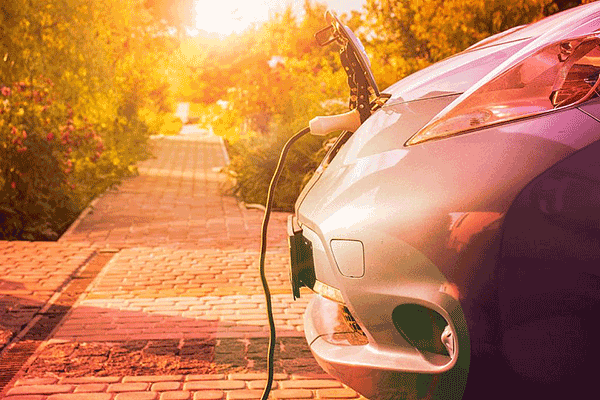It turns out that cold isn’t the only extreme weather condition to consider when it comes to EV battery performance. Heat, too, can lower driving range and cause long-term battery damage. The good news is, there are many measures you can take to mitigate the impact of hot summer driving on your EV battery.

Optimizing your vehicle for summer driving depends on how you charge your EV under hot weather conditions, among other factors. Here’s a look at how heat affects your battery and what you can do about it.
How Hot Weather Affects Your EV Battery
The lithium-ion batteries that power electric vehicles have an ideal operating range, with the sweet spot right around 70 degrees Fahrenheit. That’s where the chemical reactions required for your battery to provide power happen most efficiently. Coincidentally, it’s also where you’re most comfortable—and less likely to use heat or air conditioning that draws more power from the battery.
Most EV drivers are already familiar with the effects of cold weather on their batteries. According to data collected by Geotab, a car running in 20 degree temperatures with the heater on loses around 40% of its battery capacity, on average.
On the other end of the temperature spectrum, the impact is less severe but still notable. At 100 degrees, a typical EV battery drops to about 80% of its rated capacity. This difference is largely due to the fact that we don’t see nearly as extreme temperatures above 70 degrees as we do below it.
Heating your car requires more battery power in an EV than in a gas-powered car, as you don’t have the ready heat source of a hot engine. This puts greater demand on the battery in winter than in summer. It’s worth noting that extreme weather has a similar effect on driving range for both EVs and gas-powered cars, so this is no reason to put off that EV purchase you’ve been considering.
Tips for efficient EV charging and driving in hot weather
1. Consider the thermal management system before you buy
Because temperature control is so critical to battery performance, every EV comes equipped with a thermal management system designed to keep the battery at optimal temperatures. These come in one of two forms: active or passive thermal management.
A passive system is simpler and relies on convection to cool the battery, whether by air or phase change materials. This is a less costly setup and may be sufficient in milder climates. However, if you live in a climate with seasonal temperature extremes, you should consider an active thermal management system. This circulates liquid coolant around the battery for a much more effective cooling solution.
Before you buy an EV, consider your typical driving conditions and find out what kind of thermal management system the car has.
2. Don’t park in the sun
Every car—electric or not—soaks up heat when you park it in direct sunlight. Those scalding temperatures mean you’re already starting with a hot battery—and you’ll have to run the air conditioning that much harder to cool down. Neither of those situations is good for battery range, so be sure to park in the shade whenever possible.
3. Don’t charge fully
Although it may be tempting to max out your charge every time, this practice won’t do your battery any favors. Lithium-ion batteries perform best when you keep their charge level under 80%. Frequently charging past this level will increase resistance within your battery and accelerate long-term degradation. Unless you need more energy for a longer trip, there’s no need to charge your battery all the way.
4. Charge overnight
When it comes to charging an EV in hot weather, charging at night is ideal. By charging overnight, you avoid the extreme heat and put less pressure on the electrical grid. If your utility company offers discounted rates for overnight electricity use, you benefit even further by saving money on your electrical bills.
5. Precondition
If you live in a hot, muggy summer locale, you may find your car is already uncomfortable when you set out for work in the morning. If so, you can make your commute more efficient by preconditioning your vehicle before you leave.
Start your EV a few minutes before your commute and run the air while it’s still plugged in. That way, you’ll get your cabin to a comfortable level without draining any energy from the battery, and you won’t need to run the air as much while you drive.
6. Turn down the A/C
For less frequent EV charging in hot weather, few things matter more than how much you run the air conditioning. One study by AAA showed that battery range dropped 11% more with the air conditioning on at 95 degrees than it did without A/C. If you want to optimize your EV battery in summer, run the air conditioning less often—and keep it on low when you do.
7. Take it easy
Similar to a gas-powered car, your driving style also affects battery performance. Hard acceleration increases energy demand, and slamming on your brakes diminishes the effects of your vehicle’s regenerative braking system. Ease up on the lead foot, and your battery will thank you.
On a similar note, consider what you really need to carry in your vehicle for your summer commutes. The more weight you add, the more strain it puts on your battery, so keep it light to get a little more out of every charge.
Extreme temperatures will always impact EV battery performance, but the degree of impact is up to you. By implementing some best practices for charging your EV in hot weather and maintaining good summer driving habits, you can significantly improve battery health in hot weather conditions.














